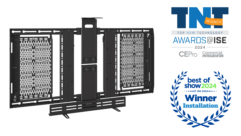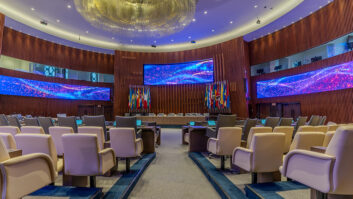
Green AV Shines Light on Window Shades
Mar 5, 2008 12:00 PM,
By Linda Seid Frembes

Daylighting, the use of natural light to illuminate a space, has become a hot topic thanks to LEED ratings and the green building movement. Schools that have incorporated skylights, atriums, or window walls are finding that window shade selection is just as important as an open design. “With green construction, buildings have more glass and therefore more light. AV dealers have to control light to create an environment for AV presentations but balance that with energy efficiency. Selecting the right window shade fabric makes all the difference,” says Clint Childress, green buildings coordinator for Draper, which started as a window shade manufacturer in 1902 before expanding its production to include projection screen and gym equipment.
Glass is a good conductor of heat but a poor insulator, so opening shades during the day to let in the sun and closing them at night will increase the efficiency of a school’s HVAC system. “Blackout shades, traditionally the kind used in schools, are not always the best for user comfort,” says Jim Campbell, business development manager for Somfy, a manufacturer of specialized motors and control systems for retractable awnings, shutters, and shades. “Eliminating all light means that you now have to turn on artificial lights, so it defeats the purpose of daylighting. Automated shades help in situations where it is not always desirable to have the shades down.”
At Spokane Falls Community College in Spokane, Wash., the new construction for the Business & Social Science Building was designed and built to LEED Silver standards. According to Campbell, the classrooms faced west, presenting an all-glass façade. To increase energy efficiency and interior comfort, the school uses sun sensors and astronomical clock to adjust the shades accordingly. A lighting system using dimmable photo sensors adjusts the artificial light over the course of the day.
“The shading system, operating over an industry-standard RS-485 SDN network, can be autonomous; a separate, centrally located motor control module is not needed. By connecting to the existing LAN, users can have local shade control via a GUI on their desktop. I am excited about the design advances offered by shading systems controlled over an addressable digital network. Configuration of the shading system is now a software task; gone are the days when interior space changes would require rewiring of the system components. The shading system can even use the existing occupancy sensors in the room,” Campbell says. “At night in the winter, the system can lower the shades at a predetermined time in the evening to take advantage of the insulating properties of the shades. That cuts down on radiational cooling, and also eliminates the ugly look of a nighttime façade with shades in various up/down positions.”
“If a school is adding a control system, they can always integrate the shading system,” Childress says.
1
Green AV Shines Light on Window Shades
Mar 5, 2008 12:00 PM,
By Linda Seid Frembes
According to LEED specifications, the goal for daylighting is to promote enjoyment, energy efficiency, as well as health and productivity of the building occupants. Campbell says that there are several studies linking increased light levels with increased student performance.
One such study was completed in 1999 for the California Board for Energy Efficiency. The board commissioned a study on the effect of increased daylight on student learning. The report was prepared by Pacific Gas and Electric Company and funded by California utility customers. The study focused on several school districts across the United States, including the Seattle school district.
The report states: “The elementary schools in Seattle had a large range of conditions. Mostly older, the schools range in age from eight to 90 years old. Most Seattle elementary schools have substantial windows with clear glass, although a few have minimal or no windows.”
After a review of each building and the student population test scores, the report found: “All other things being equal, students in classrooms with the largest window area, or the most daylight, were found to be testing 9 percent to 15 percent higher than those students with the least window area or daylighting. A 6-percent-to-7-percent effect is observed for skylit classrooms.”
For schools that are interested in automated shading systems but are housed in older buildings, there are still plenty of options. A new generation of ILT motors, as well as motors with built-in radio receivers, give users flexibility. “With ILT motors, you have the ability to put the control in the motor. You can run one circuit of power, and there is no extra real estate required for control modules,” Childress says.
Fabric selection for shades are also important, and option are usually either opaque or mesh in dark, light, or duplex fabrics. Dark fabric controls glare, light-colored fabric does well with reflecting sunlight, and duplex fabric is white on the outside and dark on the inside. “The choice depends on the needs and uses of the room. It is best to choose for performance rather than trying to match interior design colors,” Childress says.
“Solar shades are not just passive window dressing anymore; properly selected and installed, they now a dynamic and active part of today’s bioclimatic façade,” Campbell says.
2










